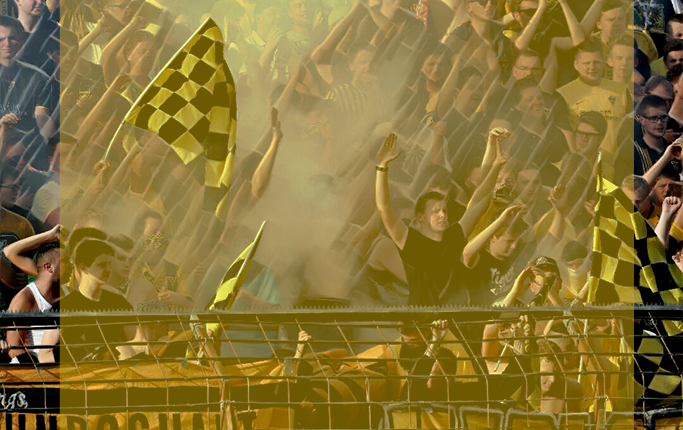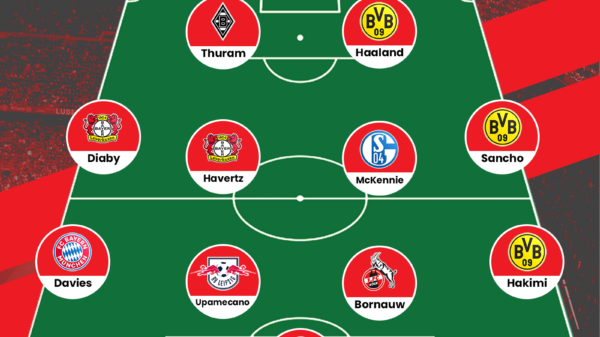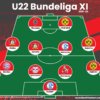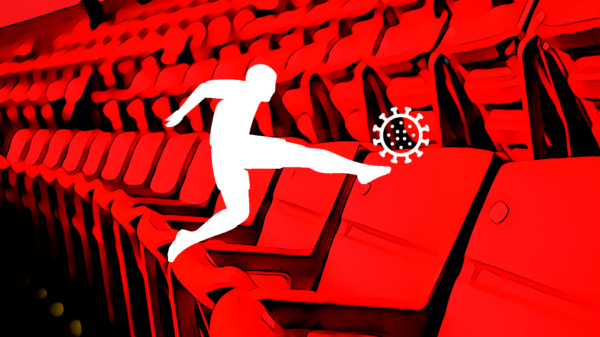
In a new series of specials, James Kelly takes a look at teams who have enjoyed a solitary top flight season in recent memory before silently fading away. To begin with, German side Alemannia Aachen.
Show a young football fan the final standings of the 2006/07 Bundesliga and I’m sure they’d be shocked at its differences from the current campaign. Recently relegated Stuttgart are champions. There’s no Hoffenheim, only just promoted from the 3rd division. Red Bull are still two years away from creating Leipzig. European giants Bayern Munich and Borussia Dortmund languish in 4th and 9th. Mönchengladbach are rock bottom with just twenty-six points to their name. Arguably the biggest question though concerns the identity of the team one place above die Fohlen; Aachener TSV Alemannia 1900.

Of the relegated sides in 2007, two very different pathways have been taken. Mönchengladbach have taken the high road back to the Bundesliga. The last few seasons at Borussia-Park have brought European football, top flight stability and quality players such as Marco Reus, Yann Sommer and Granit Xhaka. Unfortunately, Alemannia Aachen haven’t been quite so lucky, as they no longer compete in professional football. On Wednesday 23rd November 2016, both teams were in action, but whilst Gladbach drew 1-1 with Manchester City in the Champions League, Aachen crashed out of the Northwest Rhine Cup in a 1-0 loss to Fortuna Köln, watched by just 2600 supporters.
Background
Before we explore how things have gone so wrong for the club, a bit of context. Aachen is based in the far west of Germany, near the borders with Belgium and the Netherlands. A city home to some 250,000 people, it was used by German kings for coronations until the 16th century and great Frankish leader Charlemagne is buried inside the Cathedral. The football team were founded in 1900 by a group of students, using the Latin name for Germany (Alemannia) as their preferred 1.FC was already taken. They’re also rather oddly nicknamed Die Kartoffelkäfer, the Potato Beetles, after their yellow and black hooped kits.
In 1953 and 1965 they lost in German Cup finals to Rot-Weiß Essen and Borussia Dortmund, with the latter preceding a first promotion to the top flight in 1967. Two seasons later ended with a second-place finish, behind a Bayern Munich side who themselves captured their first Bundesliga. This was to be a flash in the pan, as they were relegated the next season and remained stuck in 2. Bundesliga until another relegation in 1990. Thanks to maverick coach Werner Fuchs, Alemannia did return to the second division in 1999, but not before he tragically died of a heart attack a mere few weeks before promotion, aged just fifty. Initially the extra quality of 2. Bundesliga was hard, but they slowly found their feet, finishing just one point off promotion in 2004. That same year ended in a third Pokal final, after a cup run where both Munich teams and Mönchengladbach fell to Alemannia, only for a narrow 3-2 final loss to Werder Bremen.
The last piece of the jigsaw was appointing VfB Lübeck manager Dieter Hecking in June of the that year. After a season where promotion was arguably hindered by a UEFA Cup run to the round of 16, Hecking’s chargers led the league for much of the 2005-06 season, eventually finishing second and reaching the promised land of the Bundesliga after thirty-six years away. With a squad including the likes of Vedad Ibišević, Jan Schauldraff and Mathias Lehmann, and backed by increasing funds from cup runs, consistently high attendances and a stable president, this should have been the start of something special. As Heinrichs put it in 2004, “it’s simply unbelievable, and all of our huge financial worries have disappeared.” He wasn’t to know, but this success was also the beginning of something that would cause Alemannia to suffer three relegations in ten years.
Bundesliga
The season didn’t get off to the best of starts with a 3-0 loss to Leverkusen and just two games later, Hecking cancelled his contract to move to Hannover; a decision which causes fans hatred of the former-Wolfsburg coach to this day. The side battled on under Michael Frontzeck, picking up results such as a goalless draw in Dortmund, 2-1 win over Hertha at the Olympiastadion and 1-0 home victory over Bayern. In the Pokal meanwhile they again got the better of the Bavarians, being 3-0 up at half time before running out 4-2 victors. There was even an unbeaten run from 10th February to mid-March, meaning with twelve matches to go they were in thirteenth place. The problem though was a torrid run-in against top-ranking sides. All these ended in high losses for Alemannia: 3-1 to Stuttgart, 4-1 to Dortmund, 1-0 to Nürnberg, 3-1 to Bremen, 4-0 to Hertha and 4-0 to Frankfurt.
Three points off safety in the relegation zone, with the worst goal difference and only 2 games remaining, chances of survival seemed bleak. There was still hope in the form of their last home match, a huge six-pointer against Wolfsburg, also winless in over a month and directly above them in the table. With ten minutes to go it was 2-0 to Alemannia, leaving them destined to move level on points with their opponents. Due to the awful goal difference chalked up in the aforementioned games, Aachen would not exit the relegation zone, but the final day was in their favour. On matchday thirty-four, Alemannia had midtable Hamburg, who had nothing to play for. On the other hand Wolfsburg were up against Werder Bremen, still fighting for automatic qualification to the Champions League. All Alemannia had to do was get something at the Volksparkstadion and realistically Wolfsburg would be swept aside by Klose, Diego and co.
Werder did indeed win, 2-0 if you’re interested. Sadly this was immaterial. You see we didn’t finish talking about the Alemannia-Wolfsburg game did we? Unbelievably, Christopher Lamprecht scored in the eighty-first minute for Wolfsburg. 2-1. Nervous moments. Five minutes later the same man played a ball forward to Diego Klimowicz. Moses Sichone slid in, but the Zambian’s challenge was weak. The ball bounced off the Argentine striker, who sprinted through to fire past reserve keeper Marcus Hesse. The game finished level. Mathematically still with a chance, but requiring a fourteen goal swing in their favour, yellow-and-black hearts evidently weren’t in it as they lost 4-0 at HSV.
Aftermath- Neue Tivoli
The first two seasons in the 2. Bundesliga were just short of a return, finishing seventh in 2008 and fourth in 2009. The issue however was the vision for the club held by its directors. Due to the small capacity and dilapidated condition of their Alte Tivoli stadium, the club had been looking to build a new one for several years. Originally this involved a move outside of the city to a nearby Autobahn junction, but fans and local officials alike favoured a site within the city. As part of the planning, the fans formed an initiative outlining their wishes for the new build. These included steep stands and a low, fully-enclosed roof to retain noise. These were adhered to, creating an impressive, modern arena where front row seats are just 6 metres from the pitch.
The problem is to build such a stadium, you need some money to pay for it. In Germany new stadiums are fairly common, with most teams having either moved or renovated in the past 20 years. Sometimes funding comes from local councils, but in Alemannia’s case the city refused to provide a single penny. Money was eventually secured through the North Rhine Westphalia state, various banks and club sponsor Aachener Münchener insurance. Debt problems over new stadiums are also nothing new, with MSV Duisburg and Arminia Bielefeld just two sides undergoing similar problems. In Alemannia’s case though these loans included the extremely short repayment period of 18 years. Since the state of the Alte Tivoli was so bad, the club needed to build a new one quickly or face licence revocation. As a result Alemannia were hurried into construction of their new ground.
With the stadium’s cost standing at about €46 million, repayments took the form of extraordinarily high rates. Widely quoted at about €5.5 million a season, much higher than any other team in Germany, these rose even higher when operating costs were factored in. It was estimated that an eyewatering total outlay of €7 million per season was necessary just for the club to break even. Obviously it was simply asking too much for the club to remain both competitive on the pitch and stable off it.
It is worth noting however that despite these issues and the impact it had on the club, the stadium was actually a good deal. For its 32,500 seater capacity, it didn’t cost anything out of the ordinary. To put the cost into perspective, Hoffenheim’s Rhein Neckar Arena is 2000 seats smaller and cost close to €100 million. Let’s also bear in mind this is a club that even today holds the record for most seasons in 2. Bundesliga and had realistic aspirations of another promotion to the top flight.
The opening league game in 2009 ended in a record home defeat, 5-0 to St. Pauli, whilst a supporter fell five feet from the away section. Thankfully he avoided death, but this event foreshadowed what was to come for the home team. As the years passed following their Bundesliga adventure, Alemannia started to gradually descend. In 2011/12 things came to a head as they only won six games and were relegated to the 3. Liga. With their yearly operating budget now reduced to just €2.7 million, an instant return was not expected. However the next season was even worse, as Alemannia ended twelve points off safety and faced another demotion; this time to the fourth tier Regionalliga. As the name implies, this isn’t even a nationwide league, instead being grouped by region. Alemannia now reside in the West group alongside (quite literally) giant names such as TSV Sprockhövel, SV Rödinghausen and SC Wiedenbrück 2000, along with a handful of top clubs’ reserve teams.
In 2010 a guarantee of €5.5 million from the city mayor saved the club from extinction, also enabling them to pass the licensing procedure for the following season. By the time the city decided to fully invest, obviously alarmed at the prospect of the big yellow bowl in the middle of their spa town becoming vacant, it was too late. A further €10 million was offered in 2012 to buy part of the stadium, whilst the stranglehold of the tight repayments was also extended, but by then the club had hit rock bottom. On 23rd December 2012 the club’s parent company, Alemannia Aachen GmbH, filed for bankruptcy.
In January 2015 the stadium was finally sold to the city council for €1, complete with a leaking roof as the club had been unable to pay maintenance fees. As per the sale, Alemannia partly fund the estimated running costs of €1.2 million per year. The current figure is €150 000 per season in the Regionalliga, but even this is proving difficult, as the stadium is usually only 20% full and there are still several outstanding tax liabilities. This figure would rise to €2.8 million if there ever was to be a miraculous return to the Bundesliga, whilst the city council would take a percentage of profits and player sales. The stadium has consistently been a noose around their neck, and it’s uncertain how much longer they can survive.
The Future
One solution would be vacating the Tivoli; a stadium simply too big for fourth division football. In 2014 a move to the Karl-Knipprath Stadion in nearby Jülich was explored, but the 5000 capacity was considered too small. Whilst the Tivoli is rarely full, there can still be big turnouts. A Regionalliga record of 30,000 took in the derby with Rot-Weiß Essen in 2015, whilst last October over 20,000 turned up for a game with FC Köln’s II side. One thing’s for certain, you cannot question the loyalty of supporters.
Another burning question is why has no-one invested in the team? Indeed when researching this article I was struck by how similar their situation is to Real Oviedo. In both instances the local council failed to invest, and I’m sure players such as Lewis Holtby, Torsten Frings and Simon Rolfes, all of whom launched their careers in Aachen, along with the global football community, would gladly come to their aid. Rolfes was in talks last spring, but unfortunately these proved fruitless with the ex-Leverkusen stalwart stating “the current conditions do not permit long-term reconstruction”.
One glimmer of hope could be a triumvirate of investors, currently “very interested” in purchasing 49.9% of the club. This would involve an injection of €16 million over 4 years to realise the ambition of a return to at least the 2. Bundesliga. Club members are due to vote in the spring, where at least 75% must verify the sale. Supporters remain grounded, with Fan-IG chairman Thomas Wenge remarking after initial discussions, “it sounds quite charming, but now we have to deal extensively with the contractual details”.
A possible reason for the absence of a successful takeover could be the negative image some fans have in the German media, with certain supporter’s groups being labelled neo-Nazi in the national press. This situation is undoubtedly overinflated, with the largest right wing group, the Karlsbande, officially being apolitical. This however means those with extremist sympathies are not excluded. Only last month the club issued a statement that they stood for “a family community in which everyone feels comfortable… with a respectful and non-violent approach… unfortunately these values are not observed by all groups”. Fan trouble has led to a series of fines from the DFB, and if problems persist there is the prospect of matches behind closed doors. The club can ill-afford this loss of revenue from matchdays.
Player sales also look to be another dead end, with the entire twenty-two-man squad valued at just €1.9 million on Transfermarkt. As Julian from the Alemannia-Brett forum put it, “there isn’t a truly great talent within the current list of players that is anywhere near good enough to enhance the chances of promotion into the 3. Liga anytime soon”. This seems to ring true, as at the winter break they sit fifth and thirteen points off champions spot, the only means of promotion, meaning another season in the Regionalliga is a certainty. No funds will come through the cup either, a competition they haven’t been in for three seasons after falling in the preliminaries. The loss to Fortuna Köln means they will also be absent next year.
One must question their true motives, but let’s just hope after all the misfortune Alemannia have encountered in the past decade, the investors comes good. Then who knows, a decade from now every child may know the name of the Potato Beetles.
- The Academy Series | 10 best Metz products: Pirès, Pjanić, And Mané Feature - August 21, 2017
- Promotion Heartache: 10 European clubs that just missed out - August 6, 2017
- Girona FC: Rise of the Albirrojos - May 1, 2017



























































